Cintec Anchors
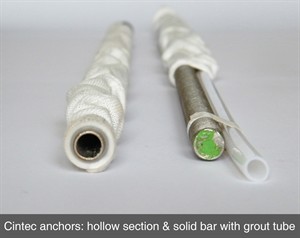 Old, historic and listed buildings and
monuments often require structural repairs, having deteriorated
over time. Traditionally pattress type plates and tie
bars were used to stabilise these structures, and repair the
cracks in the walls. However, these solutions are not always
the most aesthetically pleasing.
Old, historic and listed buildings and
monuments often require structural repairs, having deteriorated
over time. Traditionally pattress type plates and tie
bars were used to stabilise these structures, and repair the
cracks in the walls. However, these solutions are not always
the most aesthetically pleasing.
Cintec anchors are much more suitable for the restoration of
historic and heritage buildings, as they are less obtrusive
aesthetically than conventional tie bars and pattress plates.
Cintec Anchors are especially suited for the repair of
cracks in rubble filled or voided stone walls.
Stronghold Preservation are Cintec anchors approved
installers.
How Cintec Anchors Work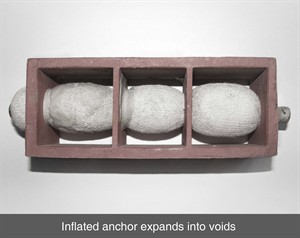
The Cintec anchor system comprises of a steel bar (or
multi-bars) enclosed in an elasticated porous fabric sleeve.
Holes are diamond drilled into the masonry or stone, into which the
anchors are placed. The grout is pressure injected under
controlled low pressure, which fills through a grout tube from the
rear to the front, until the sock is entirely filled.
Cintec Sock
The elasticated Cintec sock serves several functions; It
initially acts as a formwork for the high strength grout, allowing
it to expand tightly into the drilled hole. It will aslo expand a
further 30-50% more than the drill hole size, which allows the
grout to expand into the natural voids and contours of the wall.
This expansion into the voids provides a strong mechanical fixing
within the structure, along the entire length of the
anchor. This can reduce the requirement for any unsightly
pattress plates on the exterior of the structure, as the anchor is
bonding along it's length rather than having a point load at the
end plates.
The elasticated fabric sock allows most of the water content of
the cementitious grout (Grout milk) to pass through, whilst
leaving the concentrated, dense, non-shrink solids within the
sock.
Additionally, by allowing the 'grout milk' to pass through the
fabric sock it creates a chemical bond with the substrate in
contact with the anchor.
Inflated Cintec Anchor Detail
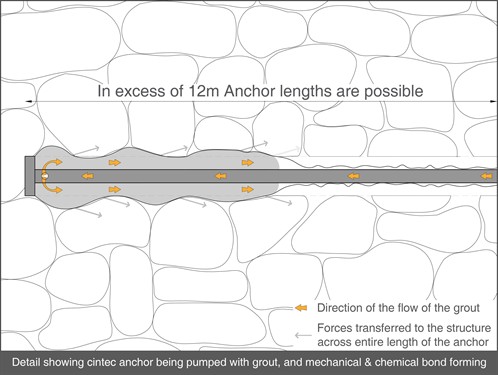
The grout is injected through a circular hollow section bar or
plastic grout tube. This allows the anchor to be pumped from one
end, filling the sock up from the rear. This process of grouting
from the rear to the front provides a high degree of quality
control, as the final part to inflate is at the front.
The grout is injected under pressure which expands the
elasticated Cintec Sock Anchor into natural voids within the wall,
creating a mechanical and chemical bond within the wall
The load is imparted more evenly than traditional anchors, due
to the bond created by the expansion into the natural voids over
the full length of the anchor.
Quality Control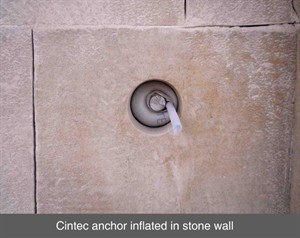
The installation process for the Cintec anchor system
automatically provides the user with a high degree of quality
control. As most anchor holes are 'blind' ie the operative cannot
see the far end, there is a risk, with other systems, that the
furthest end may not be correctly filled or surrounded in grout.
With the Cintec Anchor system, the sock will not inflate at the
front (visible end) until the remainder of the anchor has filled
with grout, therefore the installer can ensure that the entire
anchor is fully grouted. As a licensed Cintec Approved Installer,
Stronghold Preservation have been trained in these techniques.
Specialist Drilling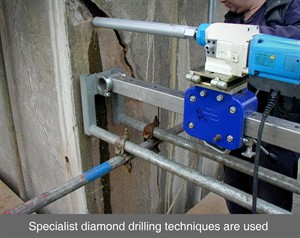
As the Cintec anchors are often installed in historic buildings
that are unstable, the drilling system msut be sympathetic to the
structure and avoid causing further damage. Specialist diamond
drilling techniques are used to drill long holes, which can be in
excess of 12m. The diamond drilling system creates little vibration
and is extremely accurate over long distances, making it ideal for
historic buildings and structures.
Often when there are structural problems in historic buildings,
the walls are voided or rubble filled, making any drilling
difficult, due to the fact that the loose core often collapses into
the drill hole after the drill bit is removed, making the insertion
of the anchor difficult if not impossible. Special hollow,
extendable diamond cores are used to keep the drill hole open and
prevent the hole closing in, allowing the Cintec Anchor to be
inserted.
Advantages of Cintec Anchors
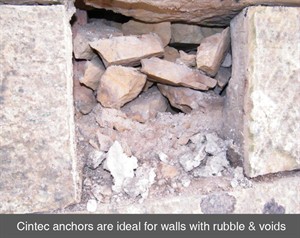
- Ideal for void filled or loose rubble filled walls
- Capable of being installed in long anchor lengths - Up to 30m
Cintec anchors have been installed
- Effective high strength anchors are possible in poor quality,
soft masonry
- Ideal for bridging cavities, without grout loss
- Good quality control in long 'blind' holes - Sock inflation at
front provides proof that the entire anchor is surrounded by
grout
- Sympathetic with existing structures - Cintec uses natural
cementitious, non-resin grouts
- Minimal visibility when installed - No pattress plates
necessary
- Resistant to fire compared to resin fixings
- Approved by heritage organisations
Applications for Cintec Anchors
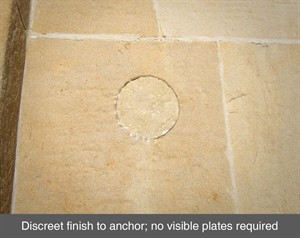
The Cintec Anchors are suitable for use in:
- Structural repairs, including corner cracks, brick arch
failure, bridges etc.
- Stabilisation of unstable structures
- Conservation: Cintec anchors are sympathetic to the building
fabric, and are suitable for the restoration of heritage buildings,
especially void filled walls.
- Strengthening the load bearing capacity of structures
- Long Anchor Lengths: Cintec anchors have been installed up to
30metres long
- Cintec anchors provide a discreet finish, and are therefore
particularly suitable to areas where high aesthetic control is
required, eg listed and heritage buildings.